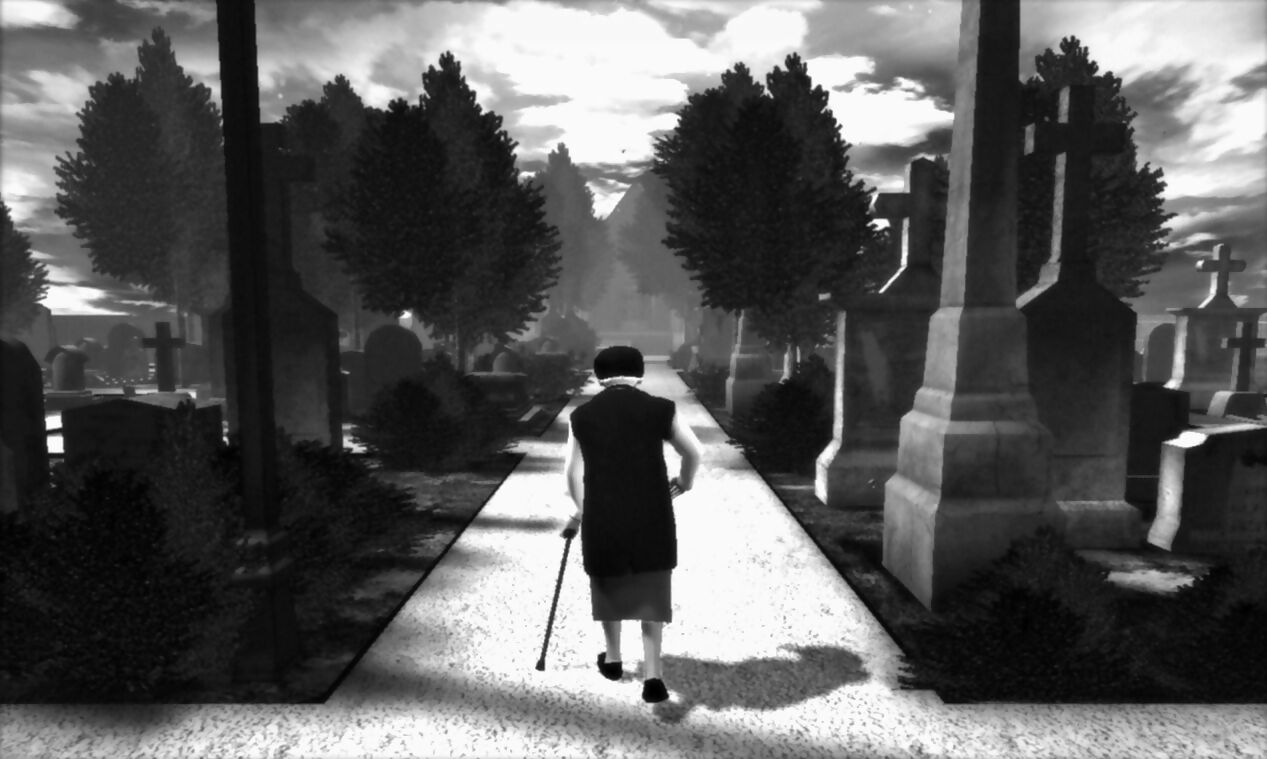
In July 2019, Ubisoft executive Alain Corre said of Helen, the elderly assassin in Watch Dogs: Legion: “Nobody has dared do anything with a granny before.” Mockery was the prevailing – and not inappropriate – response from the gaming public. This mixture of historical cluelessness and self-promoting bluster is par for the course in a triple-A industry prone to misrepresenting the progress made by indie studios as its own, but there was at least a grain of truth in Corre’s boast. In an age of expanding inclusivity, there’s a demographic glaringly absent from the endless parade of video game characters that jostle for our attention: older folk.
The developers interviewed for this piece have all made games that revolve around aged or ageing characters, and their approaches, concerns, and projections all vary. Yet there was a single constant in their replies: all of them had a hard time naming a video game character that directly influenced their own. Designer Daniel Black, who gave us sprightly septuagenarian Jack Glover in The Last Time, came the closest, relating how he “enjoyed watching Sam Fisher grow older and experience different life events through the Splinter Cell series”, though he had to concede that “you never play him at a very advanced age and he’s always in peak physical condition.”
For others, inspiration seems to have come mainly from cinema and, to a lesser extent, literature and the visual arts. We’re being presented with increasingly relatable human stories about the lives of kids, youths, and adults in games, but when the needle moves past middle age, the medium has little to offer (and, no, Token Drunk Sensei in Fighting Game doesn’t count). So where are gaming’s elderly protagonists, and do we have reasons to believe the medium is expanding to accept them?
Origins: Comedy and Exaggeration
The economic realities of the early eighties games industry could partly account for the scarcity of elderly protagonists. Games were a product aimed mainly at kids and largely made by so-called ‘bedroom coders’ – self-taught developers, often still in their teens, operating straight from their parents’ homes. These are ages, and we’ve all been there, where ‘old’ denotes someone with children and an office job, not a person in their 60s or beyond. For the majority of both producers and consumers associated with the video game market of that era, life over 65 was less than a blink on the horizon; it was a faint echo from another universe. As a result, the few elderly characters that did emerge were exaggerated caricatures; their age-based otherness played for laughs.
Bad Street Brawler (aka Street Hassle) was arguably the crassest – which isn’t to say entirely unfunny – affirmation of that paradigm. Beam Software’s notorious side-scrolling beat-’em-up had your scantily clad, mullet-sporting muscle man kick, punch, and headbutt the hell out of frail, white-haired folk. On the opposite end of the spectrum, a rather more belligerent role was reserved for 1984’s Bionic Granny (not to be confused with TV’s Super Gran – that show was the subject of two game adaptations later in the decade). In the famously terrible Bionic Granny, players controlled the titular character as she lurked outside a school, whacking departing pupils with her cane. Watch Dogs: Legion’s Helen may not have been the first elderly protagonist, but at least we’ve come this far since the eighties – Helen is, ostensibly, fighting cops in a fascist state, not assaulting a bunch of schoolchildren on their way to lunch.

A menace to society: your victims in Bad Street Brawler are not just old; they appear to be blind, too.
Bookending life narratives
If the medium’s early representations of the elderly were mostly confined to tragicomic victims or marauding hags, dubiously bolstered by the stereotypical smiling nana of a point-and-click here and the brooding wizard of an RPG there, it’s no surprise that contemporary developers find little to draw on for a more grounded story about senior characters.
Rather than attempt to scrutinise the experience of advanced age itself, it’s perhaps easier for storytellers to portray it as another stage of development – a bookend to a broader life narrative. This isn’t a new technique, having been used as early as Activision’s classic Alter Ego, which tasked you with guiding the choices of an individual from the earliest stages of infancy until their death. Jason Rohrer’s Passage is based on a similar premise, though treated in a more poetically minimalist manner, sending you, along with a spouse, down a seemingly endless, empty corridor where minute changes are gradually introduced, your hair thinning, your pace slowing, culminating in two predictable yet poignant final developments.

Ahead of its time? Among its many options, Alter Ego allowed you to pursue a university degree in your later years.
Some of the more insightful of these bookending snippets, however, aren’t necessary or even expected parts of a character arc. Brendon Chung, the mind behind Blendo Games and co-developer of Quadrilateral Cowboy, added a brief epilogue to the story of Poncho, revisiting his irrepressibly rebellious heroine several decades after her main adventure has taken place.
Following the series of proto-cyberpunk heists she executes alongside her disenfranchised besties, including a raid at the Malta Stock Exchange and sneaking into an orbiting neurosurgery ward, we return to an aged, though no less defiant, Poncho. She’s still riding her shoddy hoverbike and still living in poverty, eating instant ramen and sleeping on a dirty mattress. The latter is now crowned by a series of photos proudly displaying her youthful exploits; a collection meant to convey “the feeling of taking an honest look back at your life. What have you built, what have you destroyed, what are the tiny things you’ve done to make this world a better place?”
The gently wistful scene isn’t inserted to round off a detailed biographical narrative. On the contrary, Chung wants the player’s imagination to fill in the blanks of the gang’s story by providing “just that – a glimpse. They’ll have more adventures and great moments and low moments in the intervening years, and there’s something beautiful about knowing that.”

Quadrilateral Cowboy’s epilogue hints at a lifetime of joy and adventure.
In search of redemption
If Quadrilateral Cowboy’s bitter-sweet coda serves to validate the visible chapters of young Poncho’s story through a brief peek at her later years, then Old Man’s Journey reverses both that temporal structure and its purpose. In Broken Rules’ game, we’re tasked with solving spatial puzzles to guide the protagonist through an idyllic Mediterranean countryside as he attempts to reconnect with his estranged family. Creative director Clemens Scott argues that choosing an elderly hero “allowed us to reflect on his past life and his questionable choices, while still creating empathy for him through his journey for redemption.” In this way, skipping the character’s younger years, hinting at the pain he caused only via momentary vignettes, curtails the impulse to judge and opens up space for forgiveness, for “players to finish the game with a sense of hopefulness and pleasure.”

Alone against the elements: a sudden thunderstorm and a gaping chasm hinder progress in Old Man’s Journey.
On the other hand, The Last Time’s guilt-ridden protagonist, policeman Jack Glover, bears no responsibility for the moment that ruined his life several decades earlier. During the game’s brisk introduction, a seemingly routine burglary call turns to tragedy as the young officer’s partner is murdered in cold blood by an unstable home invader. As with Old Man’s Journey, the game mostly revolves around the protagonist’s later years, in particular, his final attempt to track down his friend’s killer. According to Daniel Black, Jack’s age “allows the player to experience obstacles that elderly people can face – loneliness, lack of respect.” A traditional point-and-click of unusual optimism and warmth, The Last Time succeeds, despite its bleak premise, in painting an uplifting picture of the newly energised Jack. He charges inside a burning nursing home to rescue a senile veteran, and busts an impressive repertory of dance moves inside a trendy nightclub, every little adventure reinforcing Black’s central message “that you’re never too old to change.”

Not all heroes wear capes; some, like Jack Glover in The Last Time, opt for comfy, patterned sweaters.
Tired bodies, lonely lives
Most of the titles discussed so far feature relatively healthy, active senior characters. Poncho remains a biker; the unnamed Old Man traverses a marathon’s length of hills and forests; and Jack transforms into a balding superhero when the need arises. But there are also games that attempt to grapple with the problems that arrive in our later years, whether mental, physical, or social. Tale of Tales has created a walking simulator in the truest sense, with the intentionally lethargic pace of The Graveyard’s heroine making an ordeal of her stroll. As her gait slowly deteriorates into a hobble and the awkward tank controls discourage thoughts of veering off path, it becomes clear that these rudimentary tweaks of movement mechanics are meant not just to comment on the physical struggles of the elderly, but also to convey a sense of encroaching isolation. A flurry of activity seems to be ignored by the old woman. Police sirens blare in the distance; the birds raise a ruckus on the trees above. But when all your conscious effort is focused toward reaching a bench to rest your weary legs, life outside fades into insignificance.

Junipers and tombstones: starting the long walk towards the bench of The Graveyard.
The Fifth Apartment’s sole character faces similar challenges but in an even more oppressive setting. Everything in her gloomy Parisian home signifies someone who has abandoned hope. The floors are rotting, there’s mould on the walls, and the plumbing seems to whisper in human voices as if her brain tries to will companionship into existence. The TV rests front and centre in an underlit living room where she spends most of her time, killing empty hours before going to bed. Arguably worst of all is the balcony, where light, street-level bustle, and an accordion rendition of, ironically, La Vie en Rose provide a harrowing counterpoint to her loneliness. A vivid portrait of alienation resulting, as co-creator Klos Cunha recalls, in a “number of people who sought me out after they finished the game, telling me it moved them and encouraged them to call their mothers and grandmothers.” The Fifth Apartment is an uncomfortable experience and, if its impact is somewhat undercut by a horror subplot forced on it by the demands of the Ludum Dare competition for which it was made, it’s a testament to Cunha, Ricardo Bess, and Bruno Poli’s talents that they still managed to generate such a response.

The last refuge of the forgotten: the old lady of The Fifth Apartment, absorbed in front of the TV.
Older folks are human, too
Thirty-five years after the antics of Bionic Granny, the release of The Stillness of the Wind seems emblematic of the medium’s changing relationship with its elder protagonists. In the intervening decades, the teenagers that casually beat up near-helpless bystanders in Bad Street Brawler have grown up. Those whose attachment to video games has withstood the demands of family life, the worries of a career, and the convenience of Netflix are now less likely to view elderly characters as a punchline. The popularity of young, lithe, presentable leads will never fade – angry grandmas aren’t taking Lara Croft and Nathan Drake away from anyone – but there’s reason to assume that as the medium’s audience gets older, their interest in relatable characters and situations will grow too. Most of the games in this piece came out over the last five years; surely, more will follow.

A short break from the daily routine: the mailman visits in The Stillness of the Wind.
The importance of The Stillness of the Wind in this historical shift lies in the way it subtly reframes the possibilities and expectations for elder protagonists. Yes, preceding games have taken a sympathetic, nuanced look at their heroes and heroines but, nevertheless, what was obvious in their stories was an anxiety to connect, the need for a dramatic hook. Talma, on the other hand, patiently caring for her remote farm, requires neither a grand redemption arc nor an appeal to our sentimentality to justify her leading role. Developer Coyan Cardenas explains how his game’s emotional restraint is “reinforced from a design perspective, too” as “the mechanics are completely focused on the mundane chores and everyday necessities of living – there is no stop and cry button, there is no give up option.” We’ll feed the animals and tend to the garden and, just before going to bed, read letters from a distant cousin or niece that has moved to the city. Her life might not make for conventional video game narrative but, through Talma, The Stillness of the Wind introduces an unprecedented degree of humanity to the medium’s elderly protagonists: no longer martyrs, monsters, or saints; just people.
It’s personal
These are often strongly personal works, channelling memories of loved ones. In The Last Time, Daniel Black based Jack’s care home on the establishment where his grandparents spent their last years. Visiting his mother in Brazil, Klos Cunha “noticed certain signs that come with age: she was getting lonelier, with her children getting more distant and close relatives passing away”, none of which was intentionally used in The Fifth Apartment, “but the feeling was there and materialised itself as a character.” Brendon Chung also hinted that “family members and relatives played a part in inspiring Quadrilateral Cowboy”, but “would prefer not to get into detail about it.”

Poncho’s tiny compartment in Quadrilateral Cowboy, the story of her turbulent life captured in the photos proudly displayed above her bed.
Silver screen
Since games tackling old age are few and far between, most developers working on them have turned to cinema, predominantly European and arthouse, for inspiration. Klos Cunha recounts how The Fifth Apartment incorporated elements from Polanski’s Apartment Trilogy and Kieślowski’s Dekalog. Clemens Scott cites animated works like Song of the Sea and The Illusionist as influences on the aesthetic of Old Man’s Journey. And Coyan Cardenas recalls an elusive Balkan documentary about an old lady “who had witnessed the town around her disappear bit by bit until she was the last remaining person” as the basis of Talma’s story.





